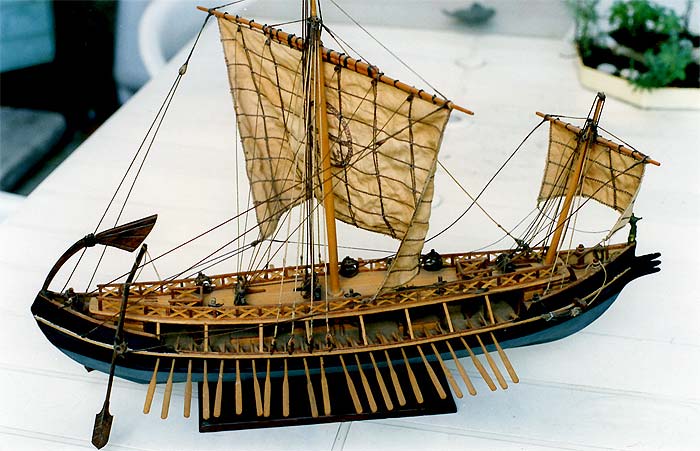On his return from his first voyage, Pytheas provided the main characteristics of ships for navigating the ocean. The Artemis will be put into construction.
We have at our disposal representations of ancient Greek ships. These can be classified into three genres :
-Rowing ships, such as Jason's in the conquest of the golden fleece.
-Sailing ships designed around the 6th century BC.
-The rigging could be diversified. Mixed ships, with sails and oars.
What type of ship can we envisage? Pentecontore in service around the 6th century BC or later the trireme, both warships? These two ships, with oars, very slender, do not seem adapted to the conditions of navigation on the high seas and to the use that Pytheas intended to make of them. We think that, the expedition having no military aim, Pytheas wanted one or more agile ships, easily maneuvering close to the coast in case of danger therefore with oarsmen, and with sails thus saving the crew a lot of effort during the crossing periods.
 |
Greek merchant ship at the time of Pytheas.
This one can embark about forty rowers |
In "Pythéas" Jean-Marie Gassend proposes a ship 18 m long, with sails and oars. The ship has a square mainsail, adjusted by a set of spars. At the front another mast, inclined towards the bow, the dolon, providing superior maneuverability, very useful for going upwind. Eighteen rowers move the ship forward in calm weather. They can also free the ship in case of urgent need. It has an awning, which allows the crew to take shelter when the weather is bad, a frequent case in the regions of Northern Europe. In total, there must have been about thirty people on board the ship. The ship carries in its holds the food necessary for the crew. But it may not be overestimated, because Pytheas already knows the situation on the edge of Europe, and he can consider supplies in Brittany or Great Britain, he may have made connections with the natives during his first voyage. He also takes everything that can be useful to him to discuss with "the Barbarians", in particular wine contained in amphorae and which is so sought after, without forgetting his portable gnomon. A small flotilla can also be considered for this expedition. Two ships, no more, because the question of financing by the Phocaean city arises. Thus, in the event of difficulty at sea, the ships can help each other. After a few tests in the harbor of Marseille, the ship (or ships) is ready to set sail. |

